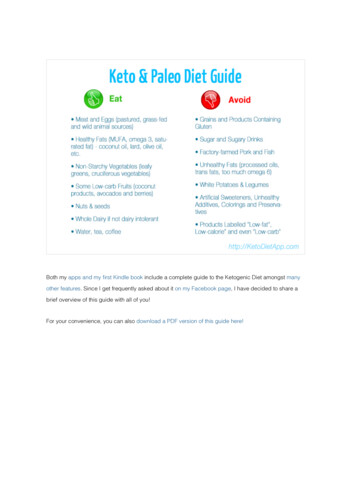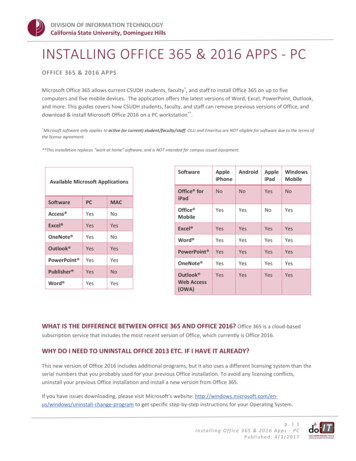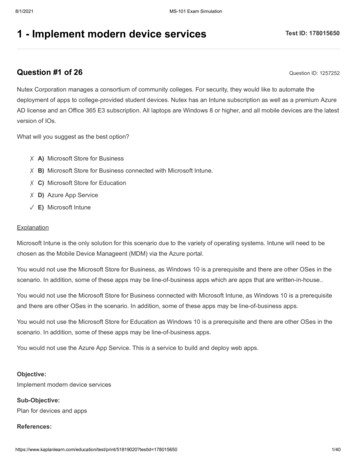
Transcription
Both my apps and my first Kindle book include a complete guide to the Ketogenic Diet amongst manyother features. Since I get frequently asked about it on my Facebook page, I have decided to share abrief overview of this guide with all of you!For your convenience, you can also download a PDF version of this guide here!
What is the Ketogenic Diet?Contrary to general dietary recommendations which have proven to be false, the ketogenic diet is ahigh-fat, moderate protein, low-carb diet. It's a diet that causes ketones to be produced by the liver,shifting the body's metabolism away from glucose and towards fat utilization. The ketogenic diet is aneffective weight loss tool and has been shown to improve several health conditions such Alzheimer's,Parkinson's, epilepsy and even cancer. Healthy cells can use ketones for energy, but cancer cellscannot and they literally starve to death. If you want to learn more about the health benefits of theketogenic diet, my good friend Franziska Spritzler, who also happens to be a qualified dieticianspecialising on low-carb nutrition, has written a great article for my blog.How does it work? Very simply said, when you eat food high in carbs, your body produces glucoseand insulin. While glucose is used as the main source of energy, insulin secretion is produced to downregulate your glucose levels in the blood stream. Insulin is also responsible for storing fat in ourbody and if your body produces too much of it, you put on weight. Excessive carbs, typical in moderndiets, combined with lack of physical activity will likely result in weight gain. Based on a comparison ofseveral scientific trials, low-carb diets outperform calorie-restricted diets in terms of long-term weightloss and health effects.
A common misconception is that ourbody, especially our brain, needsglucose. Although glucose is known tobe the primary source of energy (yourbody naturally prefers glucose), it'snowhere near as efficient as ketonebodies, especially for the brain.Depending on your goals and on howmuch you exercise, you can follow any ofthe four types of ketogenic diets:standard, targeted, cyclical or restrictedketogenic diet. All of them vary based onthe daily carb intake and the timing ofyour meals. Recent studies show that in fact, carbs before or after exercise are not needed once youget keto-adapted and your body will happily run on ketones. This has been well explained in DrVolek's and Phinney's book, The Art and Science of Low Carbohydrate Performance.Why Keto & Paleo?The Paleo / Primal diet has numerous health benefits, however if your goal is to lose weight, paleo isoften not enough. Honey, maple syrup, coconut sugar, bananas, dates or tapioca flour definitely won'tmove the scales down. As a result, our approach is not only to create recipes low in carbs but alsopaleo-friendly.The KetoDiet approach is simple: It's a low-carb diet where the focus is on eating real food. Withthe growing popularity of low-carb diets, the food industry introduced foods that may be low in carbsbut are laden with unhealthy ingredients such as artificial sweeteners, preservatives and otheradditives. It's up to you to decide how much Paleo you allow in your low-carb diet: What works forone, may not work for another. In general, if your goal is to lose weight, you have to limit your carbintake even if it comes from healthy paleo sources.Although some bloggers and authors distinguish between the "paleo" and "primal" approach, I likemany others use these terms interchangeably. I do sometimes use raw dairy in my recipes but Ialways try to include alternatives. If you don't use dairy, my 30-Day Clean Eating Challenge may be a
good fit for you.How Do I Know I'm in Ketosis?There are a few ways for you to find out whetheror not you are in ketosis. Although the mostaccurate way is to use a blood ketone meter, youcan also use urine ketone strips or simply yourcommon sense and listen to your body signals.You can learn more about Ketosis & MeasuringKetones in this post.Get Your Macros RightWhen you follow the ketogenic diet, it is critical that you get the macronutrient ratio right. Ideally, youshould be eating:5-10% of calories from carbs (netcarbs). Typically, 20-30 grams of netcarbs is recommended to start with.15-30% of calories from protein and65-75% of calories from fat in order tobenefit from ketone bodies producedby your liver.The exact amount of fat and protein is a matter ofindividual body responses and activity levels.However, most people on ketogenic diets don'tconsume over 5% of calories from carbohydrates. You can read more about your ideal macros in theposts below:All You Need to Know About Carbs on a Low-Carb Ketogenic Diet
How Many Carbs per Day on a Low-Carb Ketogenic Diet?Complete Guide to Fats & Oils on a Low-Carb Ketogenic DietAll You Need to Know About Protein on a Low-Carb Ketogenic DietYou may find it easier to use an app to track your macronutrients. My iPad app can track yourmacronutrients and do a lot more to help you achieve your goals.Should I Count Calories?It's a common misconception that you can eat unlimited amount of calories and still lose weight. Infact, you can put on weight even on a low-carb diet. Although this doesn't happen often, you will needto understand a few basic principles and avoid common mistakes.Low-carb ketogenic diets are naturally sating and act as appetite suppressants. This is why you'll eatless and won't need to count calories which is one of the three main effects of the ketogenic diet.However, if for any reason your weight is stalling for more than 2-3 weeks, you may need to considerkeeping an eye on your energy intake (calories). Reaching a weight loss plateau may be caused by
several reasons and you don't necessarily have to be eating too much, infact, you may discover that you haven't been eating enough. In myexperience, losing body fat becomes more and more difficult as youget close to your target weight.To make it easy for you to calculate your ideal macronutrients ona ketogenic diet, we developed a free online keto calculator,KetoDiet Buddy - try it now!What to Eat and What to AvoidIn short, you should eat REAL food (meat, eggs, nuts, yogurt, vegetables and occasionally somefruits). Apart from the obvious limitation of net carbs content in food, it is also recommended to avoidprocessed food and any food that may contain preservatives and colourings.KetoDiet is not just about losing weight at any cost; it's about adopting a healthierlifestyle.Below is a list of the most common low-carb foods recommended for the ketogenic diet. If you get myiPad app, you'll be able to search through thousands of foods included in the KetoDiet database.EAT FreelyGrass-fed and wild animal sourcesgrass-fed meat (beef, lamb, goat, venison), wild-caught fish & seafood (avoid farmed fish),pastured pork and poultry, pastured eggs, gelatin, ghee, butter - these are high in healthyomega 3 fatty acids (avoid sausages and meat covered in breadcrumbs, hot dogs, meatthat comes with sugary or starchy sauces)offal, grass-fed (liver, heart, kidneys and other organ meats)
Healthy fatssaturated (lard, tallow, chicken fat, duck fat,goose fat, clarified butter / ghee, butter,coconut oil)monounsaturated (avocado, macadamia andolive oil)polyunsaturated omega 3s, especially fromanimal sources (fatty fish and seafood)Non-starchy vegetablesleafy greens (Swiss chard, bok choy, spinach, lettuce, chard, chives, endive, radicchio,etc.)some cruciferous vegetables like kale (dark leaf), kohlrabi, radishescelery stalk, asparagus, cucumber, summer squash (zucchini, spaghetti squash), bambooshootsFruits, Nuts and Seedsavocado, coconut, macadamia nutsBeverages and Condimentswater (still), coffee (black or with cream or coconut milk), tea (black, herbal)pork rinds (cracklings) for "breading"mayonnaise, mustard, pesto, bone broth, pickles, fermented foods (kimchi, kombucha andsauerkraut) - best home-made with no additivesall spices and herbs, lemon or lime juice and zestwhey protein (beware of additives, artificial sweeteners, hormones and soy lecithin), eggwhite protein and gelatin (grass-fed, hormone free)Eat Occasionally
Vegetables, Mushrooms and Fruitssome cruciferous vegetables (white and greencabbage, red cabbage, cauliflower, broccoli,Brussels sprouts, fennel, turnips, rutabaga /swede)nightshades (eggplant, tomatoes, peppers)some root vegetables (parsley root), springonion, leek, onion, garlic, mushrooms, wintersquash (pumpkin)sea vegetables (nori, kombu), okra, beansprouts, sugar snap peas, wax beans, globe or French artichokes, water chestnutsberries (blackberries, blueberries, strawberries, raspberries, cranberries, mulberries, etc.),rhubarb, olivesGrain-fed animal sources and Dairybeef, poultry, eggs and ghee (avoid farmed pork, it's too high in omega 6s!)dairy products (plain full-fat yogurt, cottage cheese, cream, sour cream, cheese) - avoidproducts labeled as "low-fat", most of them are packed with sugar and starch and have littlesating effectbacon - beware of preservatives and added starches (nitrates are acceptable)Nuts and seedspecans, almonds, walnuts, hazelnuts, pine nuts, flaxseed, pumpkin seeds, sesame seeds,sunflower seeds, hemp seedsbrazil nuts (beware of very high level of selenium - don't eat too many of them!)Fermented soy productsif eaten, only non GMO and fermented soy products (Natto, Tempeh, soy sauce or paleofriendly coconut aminos)Edamame (green soy beans), black soybeans - unprocessed
Condimentshealthy "zero-carb" sweeteners (Stevia, Swerve, Erythritol, etc.)thickeners: arrowroot powder, xanthan gum (keep in mind xanthan gum is not paleo-friendly- some people following the paleo diet use it, as you only need a very little amount)sugar-free tomato products (puree, passata, ketchup)cocoa and carob powder, extra dark chocolate (more than 70%, better 90% and beware ofsoy lecithin), cocoa powderbeware of sugar-free chewing gums and mints - some of them have carbsSome Vegetables, Fruits, Nuts and Seeds with Average Carbohydratesroot vegetables (celery root, carrot, beetroot, parsnip and sweet potato)apricot, watermelon, Cantaloupe / Galia / Honeydew melons, Dragon fruit (Pitaya), peach,nectarine, apple, grapefruit, kiwifruit, kiwi berries, orange, plums, cherries, ears, figs (fresh)dried fruit (dates, berries, raisins, figs, etc.) – only in very small quantities (if any)pistachio and cashew nuts, chestnutsAlcoholdry red wine, dry white wine, spirits (unsweetened) - avoid for weight loss, only for weightmaintenanceAVOID Completely: Food rich in carbohydrates, factory-farmed meat andprocessed foods1) All grains, even whole meal (wheat, rye, oats, corn, barley, millet, bulgur, sorghum, rice, amaranth,buckwheat, sprouted grains), quinoa and white potatoes. this includes all products made from grains(pasta, bread, pizza, cookies, crackers, etc.) sugar and sweets (table sugar, HFCS, agave syrup, icecreams, cakes, sweet puddings and sugary soft-drinks)2) Factory-farmed pork and fish are high in inflammatory omega 6 fatty acids and farmed fish maycontain PCBs avoid fish high in mercury.
3) Processed foods containing carrageenan (e.g. almondmilk products), MSG (e.g. in some whey protein products),sulphites (e.g. in dried fruits, gelatin), BPAs (they don'thave to be labeled!), wheat gluten4) Artificial sweeteners (Splenda, Equal, sweetenerscontaining Aspartame, Acesulfame, Sucralose, Saccharin,etc.)5) Refined fats / oils (e.g. sunflower, safflower,cottonseed, canola, soybean, grapeseed, corn oil), transfats such as margarine.6) "Low-fat", "low-carb" and "zero-carb" products (Atkins products, diet soda and drinks, chewinggums and mints may be high in carbs or contain artificial additives, gluten, etc.)7) Milk (only small amounts of raw, full-fat milk is allowed). Milk is not recommended for severalreasons. Firstly, from all the diary products, milk is difficult to digest, as it lacks the "good" bacteria(eliminated through pasteurization) and may even contain hormones. Secondly, it is quite high incarbs (4-5 grams of carbs per 100 ml). For coffee and tea, replace milk with cream in reasonableamounts. You may have a small amount of raw milk but be aware of the extra carbs.8) Alcoholic, sweet drinks (beer, sweet wine, cocktails, etc.) - you can try my healthier versions ofpopular cocktails and drinks.9) Tropical fruit (pineapple, mango, banana, papaya, etc.) and some high-carb fruit (tangerine,grapes, etc.) – tropical and sweet fruit should be eaten only as a pre-workout snack or whenmaintaining weight - not suitable for weight loss! Also avoid fruit juices (yes, even 100% fresh juices!)- better to drink smoothies if any, but either way very limited. Juices are just like sugary water, butsmoothies have fiber, which is at least more sating. This also includes dried fruit (dates, raisins, etc.)if eaten in large quantities.10) Mainly for health reasons, avoid soy products apart from a few non-GMO fermented productswhich are known for their health benefits. Also avoid wheat gluten which may be used in low-carbfoods. When you give up bread, you shouldn't eat any part of it. Beware of BPA-lined cans. If
possible, use naturally BPA-free packaging like glass jars or make my own ingredients such as ghee,ketchup, coconut milk or mayonnaise. BPA has been linked to many negative health effects such asimpaired thyroid function and cancer. Other additives to avoid: carrageenan (e.g. almond milkproducts), MSG (e.g. in some whey protein products) and sulfites (e.g. in dried fruits, gelatin)Net Carbs in commonly used recommended foodsAnimal productsNet Carbs (grams)Serving sizemeat and fish0150g / 5.3 ozorgan meats, liver (average)3150g / 5.3 ozprawns (cooked)1.4150g / 5.3 ozeggs0.7piece, largecream (full-fat)1.6¼ cup, 60 ml / 2 fl ozbutter01 tbspcheese (hard)0.430g / 1 ozcream cheese (full-fat)1.6¼ cup, 50g / 1.75 ozVegetablesNet Carbs (grams)Serving sizelettuce (sliced, average)0.51 cup, 50g / 1.75 ozswiss chard, sliced0.81 cup, 35g / 1.25 ozcollard greens, sliced0.81 cup, 35g / 1.25 ozbok choy, sliced0.81 cup, 70g / 2.4 ozasparagus2.7150g / 5.3 ozgreen beans6.4150g / 5.3 ozsummer squash (zucchini / courgette)3.2150g / 5.3 ozwinter squash (pumpkin)9150g / 5.3 ozcucumber2.2150g / 5.3 ozspinach, cooked1.2½ cup, 90g / 3.2 ozkale (Italian dark-leaf)2.1150g / 5.3 ozkale (curly)5.4150g / 5.3 ozsavoy cabbage4.5150g / 5.3 ozcabbage (white)5150g / 5.3 ozcabbage (red)7.9150g / 5.3 ozcelery stalk1.63 medium, 120g / 4.2 ozpeppers (green)3.5piece, 120g / 4.2 ozpeppers (red)4.7piece, 120g / 4.2 oz
tomatoes, chopped4.81 cup, 180g / 6.3 ozeggplant (aubergine)3.5150g / 5.3 ozbroccoli, chopped6.1150g / 5.3 ozcauliflower4.5150g / 5.3 ozmushrooms, white3.4150g / 5.3 ozmushrooms, brown5.6150g / 5.3 ozonion, white (sliced)2.2¼ cup, 40g / 1.4 ozgarlic0.91 cloveFruitNet Carbs (grams)Serving sizestrawberries, sliced4.7½ cup, 85g / 2.9 ozraspberries3.3½ cup, 62g / 2.2 ozblackberries3.1½ cup, 72g / 2.5 ozblueberries8.9½ cup, 74g / 2.6 ozavocado3.7piece, average (200g / 7 oz)Nuts & SeedsNet Carbs (grams)Serving sizemacadamia nuts1.530g / 1 ozalmonds2.730g / 1 ozpecans1.230g / 1 ozhazelnuts230g / 1 ozwalnuts230g / 1 ozcashew nuts7.630g / 1 ozpumpkin seeds1.330g / 1 ozsunflower seeds3.230g / 1 oztahini (unsweetened sesame paste)1.81 tbspchia seeds0.41 tbsppistachio nuts4.930g / 1 ozCondiments & OtherNet Carbs (grams)Serving sizealmond milk (unsweetened)0.3¼ cup, 60 ml / 2 fl ozcoconut milk1.6¼ cup, 60 ml / 2 fl ozcoconut milk (creamed)2.7¼ cup, 60 ml / 2 fl ozolives0.230g / 1 oz
sauerkraut (solids only)0.5¼ cup, 35g / 1.25 ozmustard5.71 tbsptomato puree5.71 tbspapple cider vinegar0.11 tbspcoconut aminos11 tbspdark chocolate (85%)5.730g / 1 ozcoconut flour3.2¼ cup, 30g / 1 ozalmond flour2.2¼ cup, 25g / 0.9 ozflax meal0.6¼ cup, 38g / 1.3 ozpsillium hush powder1.4¼ cup, 16g / 0.6 ozErythritol0.51 tbspstevia (drops) 0.1¼ tspwine (red, dry)61 glass / 5 fl ozwine (white, dry)61 glass / 5 fl ozspirits (sugar-free, 40% vol)01 jigger / 1.5 fl ozTwo Weekly Keto & Paleo Diet PlansStarting the ketogenic diet may be challenging for those who are new to it. To make it easy for you, Ihave created 2 weekly meal plans which include a print-friendly shopping list and useful tips for mealpreparation to save time and money. Both of these plans are dairy-free and don't include anysweeteners, even low-carb sweeteners. You can add raw dairy and use stevia if you prefer to. I wouldpersonally avoid all sweeteners for a start, as they may cause cravings. You can read more aboutsweeteners in my post here: Complete Guide To Sweeteners on a Low-carb Ketogenic Diet7-Day Diet Plan (Clean Eating Challenge)7-Day Grab & Go Keto/Paleo Diet PlanYou can search through the many recipes on my blog to find what fits your needs. If you need to limityour search to any special requirements, use the "categories" on the right side of my blog.
KetoDiet in a Nutshell1) Basic PrinciplesStick with the keto ratio: 60-75% of calories from fat, 15-30% calories from protein and 510% calories from net carbs.Start by getting the daily net carbs (total carbs without fiber) down to less than 50 grams,preferably 20-30 grams. Increase slowly to find the optimal carbs intake. Most of you willbe able to stay in ketosis at 20-30 grams of net carbs per day. Find the carbs limit thatallows you to stay in ketosis.Keep your protein intake moderate. Preferably, use your body fat percentage to get thebest estimate for your optimal protein intake (0.6 to 1 grams per pound of lean body massor 1.3 to 2.2 grams per kg of lean body mass).Increase the proportion of calories that come from healthy fats (saturated, omega 3s,monounsaturated)If your net carbs limit is very low (20 grams and below), avoid eating fruit and low-carbtreats.Eat when you are hungry, even if it's a meal a day. Don't let others dictate what you eat orhow often you eat.You don't have to limit quantities of food deliberately, but you should stop eating when youfeel full, even if the plate is not empty - keep it for later.Don't count calories - listen to your body needs. Ketogenic and low-carb diets have anatural appetite control effect and you will eat less. Keep an eye on your calorie intake only
if you reach a weight loss plateau, try KetoDiet buddy to find your ideal macros.Increase the amount of water you drink - at least 2-3 litres a day.2) Stock your pantry with healthy foodsLearn to eat real food like eggs, meat and nonstarchy vegetables. Contrary to what we havebeen told for decades, these are good for you!If you need to snack, opt for healthy foods highin fat (foods containing coconut oil, macadamianuts, avocados, etc.)Include healthy foods like fermented foods,bone broth and offal in your diet.Don't be afraid of saturated fat and use it forcooking (coconut oil, butter, ghee, lard, tallow,palm oil - organic from sustainable agriculture).Use unsaturated fats for salads (olive oil, nutoils, sesame oil, flaxseed oil, avocado oil organic, extra virgin). Some can be used forlight cooking.Avoid all processed vegetable oils, margarine, hydrogenated oils, partially hydrogenatedoils, trans fats, canola oil, soybean oil, grapeseed oil and corn oil.Eat raw dairy (or none in case of allergies). Look for raw, organic, grass-fed dairy. Avoidmilk (high in carbs) or use small amounts of unpasteurized full-fat milk.If you eat nuts, consider soaking and dehydrating them.Check out my Amazon Store to get ingredients and foods I use!3) Increase your electrolyte intake (sodium, magnesium andpotassium)Macronutrients (fat, protein and carbs) are not the only aspect you should focus on - micronutrients(vitamins and minerals) are equally important. Those that are known to be deficient, especially in verylow-carb diets such as below 20 g net carbs, are electrolytes. You can learn more about them here:
"Keto-flu" and Sufficient Intake of ElectrolytesHere are a few tips to get your daily electrolytes:Potassium: eat avocados,mushrooms, fatty fish such as salmonand add potassium chloride to yourregular salt (or mix ½ teaspoon in 1litre of water and drink throughout theday). Be very careful with potassiumsupplements, never exceed therecommended daily intake!Magnesium: eat a handful of nuts every day to boost our magnesium intake and takemagnesium supplement. If you eat less than 20-25 grams of net carbs, it will be verydifficult to get to your daily targets.Sodium: Don't be afraid to use salt (I like pink Himalayan rock salt) and drink bone broth oruse it in your everyday cooking.4) Beware of hidden carbs and unhealthy ingredientsRead the labels and avoid hidden carbs (Maltitol, Sorbitol, etc.), unnecessary additives,preservatives, colourings or artificial sweeteners. These could be found even in chewinggums and mints. Not only they can trigger cravings but they are also linked to manynegative health effects. If you use sweeteners, here is a list of suitable sweeteners, opt forthose with no effect on blood sugar.Avoid anything labeled as "low-fat" or "fat-free", as it usually has artificial additives and extracarbs. It also has no sating effect and you will feel hungry soon after you eat it.Avoid products labeled "low-carb" or "great for low-carb diets". It has been shown that mostof these commercially available products are nor low-carb neither healthy!Beware of medications (cough syrups and drops and many other) containing sugar and tryto find sugar-free replacements.5) Don't trust products labeled "low-carb", focus on foods naturallylow in carbs
Make sure you always opt for real unprocessedfood and avoid prepared meals full of additivesand deceptive labelling. Low-carb products areoften higher in carbs than they claim to be andoften contain artificial additives.It's no secret that aspartame, which is anartificial sweetener found in diet soda, hasshown to have many adverse effects on ourhealth. Also, keep in mind there are strongfinancial interests to cover this up and deceiveconsumers. You can read more in the following posts:Is Aspartame Safe? andAll You Need to Know About Carbs on a Low-Carb Ketogenic DietComplete Guide To Sweeteners on a Low-carb Ketogenic Diet6) Plan your diet in advance and avoid "accidents"To save time and money, you will need to plan your diet in advance, especially if you are new to it.Here are a few tips before you get started:Get rid of anything that is not allowed on the diet (flour, sugar and sugary snacks, bread,processed foods, etc.) to avoid temptation. Trust me, if it's in your house, you will likelycrave it. This way you will avoid unnecessary "fridge accidents" that may ruin your efforts.If you have sugar cravings, have a glass of water (still or sparkling) with fresh juice from 1/2lime or lemon and 3-5 drops of stevia. Drink tea (green, herbal, black) and coffee withcream.Make a list of your weekly shopping for meals you are planning to cook. My 7-Day Grab &Go Keto/Paleo Diet Plan includes a shopping list ready to be printed.To save time and money, have hard boiled eggs and cooked meat ready to be used insalad or for a quick snack. Slow cooked meat like this one could be used in many differentways (in omelettes or on top or lettuce and other vegetables). Meats suitable for slowcooking are cheaper and can be cooked in advance. I use this slow cooker or you cansimply cook it in the oven on low-medium covered with a lid.
Make sure you always have keto-friendly foods on hand (eggs, avocado, non-starchyvegetables, meat, cheese, nuts or even home-made protein bars. Foods rich in protein arevery sating and will help you overcome hunger cravings.7) Get an App to get started & track your progressPlanning and tracking your diet is highly recommended, especially if you are new to the diet. It's veryeasy to go over your carbs limit or to miss your protein targets.You can get my iPad app which has been designed specifically for low-carb, ketogenic & paleo diets.Not only you will find many keto & paleo friendly recipes but you will also be able to easily plan andtrack your diet. Although it is currently available only on the iPad, we are working to bring all thefeatures to the iPhone too and make it a universal App.For those who have an iPhone, I have created a "Basic" version of the app (includes recipes and acomplete guide to keto but no planner). I have also authored a Kindle book for everyone else whodoesn't use Apple devices. You can read my book on any device provided you download the Kindlereading app (free).You can learn more about what KetoDiet offers on my website and compare all the features.
8) Keep Motivated, You Are NOT Alone!Join the KetoDiet support group on Facebook and share your experiences! I created this group forsharing everything about low-carb, keto & paleo living including your favourite recipes, interestingarticles and success stories. Feel free to post your recipe creations, progress updates and anyquestions you may have about the ketogenic diet.Here are just a few inspirational progress pictures to help you get started :-)Mike and Jennifer lost a total of 163 pounds in 90 days! Too good to be true? You can learn moreabout their success by joining his group on Facebook!
Marlize and her incredible transformation in just 7 months! Did you notice those pants? :-) Marlizecontinued losing weight until she reached her goal weight and she now looks stunning!
Brooke after 9 weeks of keto-adaptation. Look at those abs!
A few last wordsBe strong during the first few days. Think of this time as something that will soon pass.There will be cravings and negative side effects over this period. Once it's over you will feelgreat and full of energy!Imagine yourself a few pounds lighter wearing your old jeans and keep being positive!Stress will only have a negative effect on your weight loss.If there is any reason you cannot avoid eating more carbs than you should, remember to dosome physical activity to burn them. It is recommended you do some exercise no later thanan hour after you eat extra carbs. If you're at a party, dance all night! And don't get in thehabit of eating more carbs than you should.
If you disrupt your diet, don't get depressed; just go back to your plan the day after!Finally, DON'T let anyone make you think you can't lose weight! And don't believe it'sgenetics. People may think you eat the wrong food - ignore them; it's your life and yourhealth!
- some people following the paleo diet use it, as you only need a very little amount) sugar-free tomato products (puree, passata, ketchup) cocoa and carob powder, extra dark chocolate (more than 70%, better 90% and beware of soy lecithin), cocoa powder beware of sugar-free











